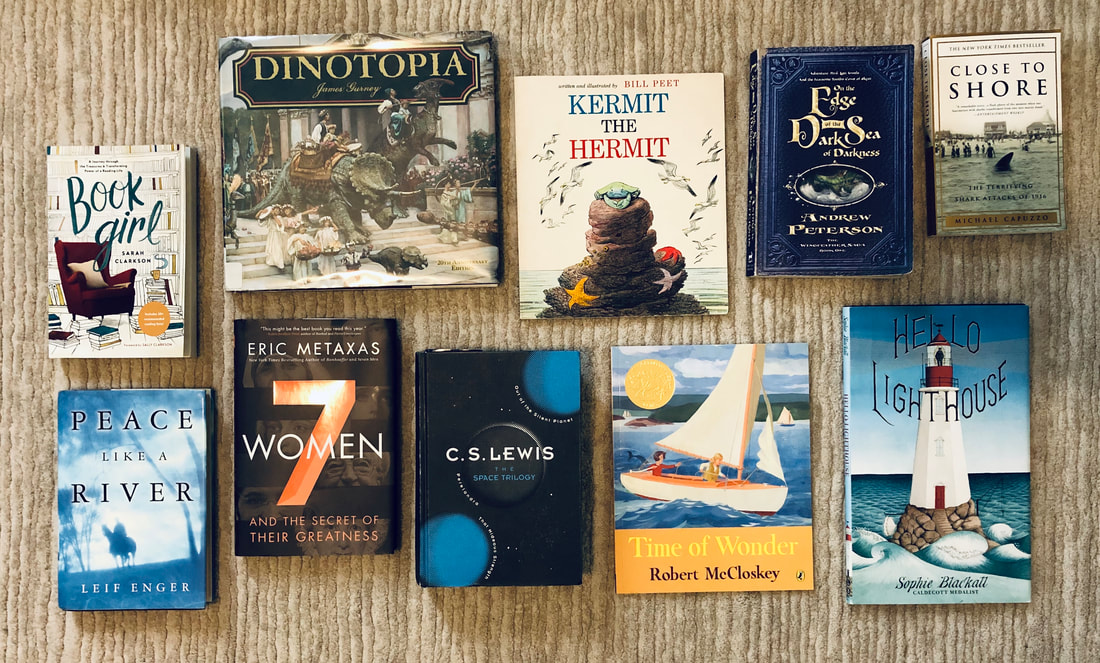|
Home schooling families likely have sagging shelves filled with books. Or at least a few neat bookcases lined with necessary titles. But a room full of books doesn’t ensure a house full of readers. Maybe it’s the rest of life’s distractions, or just not knowing where to start, but “getting into” reading can be a challenge. With the absence of our libraries right now, we’re at an even greater disadvantage. As summer opens up ahead of us, with perhaps more time on our hands than usual, what are your reading goals?
As No. 1 in my (probably irregularly-spaced) newsletter, I’d like to highlight a few books for your families to consider over the summer. If you can get your hands on them, these are a few gems. Summer favorites for young readers: Time of Wonder by Robert McCloskey. Though he’s more famous for Make Way for Ducklings, Robert McCloskey also won a Caldecott for this lesser-known picture book. It’s a slow-moving story of summer life on the islands of Maine. It also has the unusual distinction of being written in second-person. Take a few days to read this one slowly. Hello Lighthouse by Sophie Blackall. Bring the tissue box, not for your child, but for you. This one gets me teary-eyed every single time, even though I know what’s coming. Lighthouse life, family life, hellos and goodbyes. Kermit the Hermit by Bill Peet. My six year old picked this as a favorite summer-themed book. It’s about a selfish crab and what kindness does to a crunchy old heart. It also rhymes. Imaginative picks for growing readers: On the Edge of the Dark Sea of Darkness by Andrew Peterson. I just started the Wingfeather Saga this spring after seeing how many of my middle schoolers were reading it. It’s written to appeal to middle schoolers (i.e. the humor might not be to my style), but I was impressed with the storytelling. I also hope it will be a stepping stone for readers toward the more advanced fantasy of Lewis and Tolkien. Dinotopia by James Gurney. Don’t let your skilled readers turn up their noses at this because it’s a picture book. Dinotopia is a richly developed mythical fantasy that happens to be accompanied by stunning paintings on every page. I adore this book. (Note: Evolution is assumed in this story, so this is a good one to read with your kids for a chance to talk about how God as creator can apply to a fictional story that plants dinosaurs in the nineteenth century.) Nonfiction for parents: Close to Shore by Michael Capuzzo. If you vacation at the beach, skip this one. If you’re landlocked (and you don’t mind a real-life horror tale), this is a tremendously interesting story about the real shark attacks that inspired Jaws. Book Girl by Sarah Clarkson. If you’re a reader, you’ll gobble up all of Sarah’s defenses of why reading (all genres!) matters, and you’ll drool over her extensive book lists. If you’re not much of a reader yet, she will convince you to pick up a book – almost any book – and dive into the worlds tucked between the pages. Seven Women by Eric Metaxas. A short treatment of seven women of faith from diverse backgrounds and time periods. I appreciated the brevity: a much smaller commitment than a full-fledged biography on one person. Be inspired and maybe even choose one woman to read more deeply about. Novels for high schoolers and adults: The Space Trilogy by C. S. Lewis. Don’t be put off if you’re not into Star Trek. The fact that two of the three books in this series take place on other planets is secondary to the unmatched storytelling and truthtelling of Lewis. Fantasy, yes. But deeply rooted in sound theology too. Peace Like a River by Leif Enger. I can’t tell you much without ruining it. It’s sweet and painful and thrilling and beautiful. It’s one of the best modern-day novels I know. Just go ahead and buy a copy.
0 Comments
Leave a Reply. |
curated by Brittany Mountz
English major and unsuspecting English educator at ALC Archives
May 2024
Categories |

 RSS Feed
RSS Feed